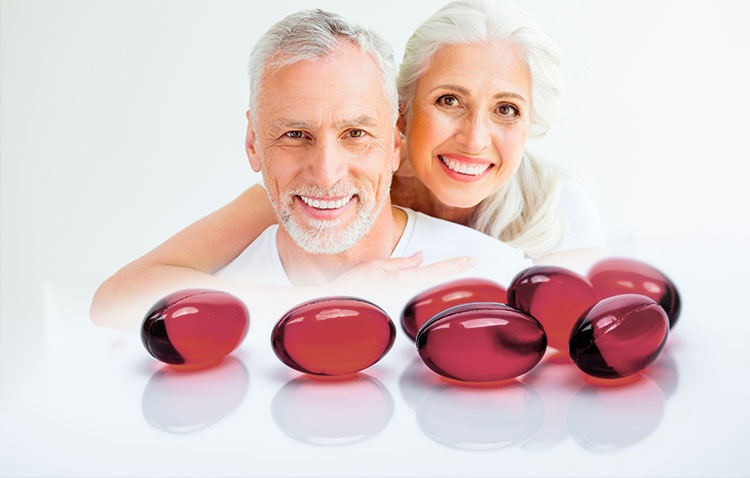
IN PREVIOUS ARTICLES, WE HAVE ANALYZED WHAT ASTAXANTHIN IS AND HOW SCIENTISTS ARE ATTRIBUTING THE POWER OF SALMON TO BRING UP THE RIVER TO THIS NATURAL PIGMENT, WHICH IS THE BEST ANTIOXIDANT THAT EXISTS TODAY.
In this article we are going to delve into the beneficial effects of this “miracle of nature” on the human body. And, for this, we will begin in the analysis of its properties, based on the scientific research carried out so far.
Remember that Astaxanthin is a carotenoid of the xanthophyll family, a natural pink or reddish pigment that is extracted from some unicellular algae (microalgae), where the microalgae Haematococcus Pluvialis stands out, as it is the largest producer of this pigment proportion to the rest of organisms (it accumulates it in a proportion of even 5% of its dry weight).
The human being cannot synthesize Astaxanthin, therefore, it must be obtained through food, or from nutritional supplements, also called nutritional supplements (Fry, Schilling, Chiu, Hori and Weiss, 2013).
Let us also remember that carotenoids are nutrients known to be effective antioxidants capable of protecting our cells from the attacks of certain free radicals. Of all the existing ones, Astaxanthin is the most powerful carotenoid that exists, due to its high antioxidant action, to the point of being considered “The King of antioxidants”.
Different studies, aimed at finding the differences between Astaxanthin and other carotenoids, indicate multiple health benefits of Astaxanthin (Wang, Sommerfeld and Hu, 2019; Li, Vallabhaneni and Wurtzel, 2018; Welsch, Wust, Bar, Salim and Beyer , 2018).
And, among the properties that have been attributed to it, we can highlight the results found at various levels. Let’s see what they are:
1 – PROPERTIES OF ASTAXANTHIN IN THE SKIN
 Astaxanthin Benefits Astaxanthin is among the most powerful and versatile antioxidants known, and as such has the ability to scavenge skin-damaging free radicals (Arakane, 2002). Although astaxanthin is widely distributed through most organs in the body, it accumulates in the skin, where it enters all of its layers (topical sunscreens can only reach the outermost layers).
Astaxanthin Benefits Astaxanthin is among the most powerful and versatile antioxidants known, and as such has the ability to scavenge skin-damaging free radicals (Arakane, 2002). Although astaxanthin is widely distributed through most organs in the body, it accumulates in the skin, where it enters all of its layers (topical sunscreens can only reach the outermost layers).
Skin cells that are exposed to ultraviolet light produce bursts of free radicals that trigger aging effects such as sagging skin, wrinkles, and cancer. Studies show that when Astaxanthin is applied to cultured skin cells, it prevents all the destructive effects induced by ultraviolet light (Melten, Imamoglu, & Demirel, 2017).
Human studies (in both men and women) show that Astaxanthin 6 mg / day for 6-8 weeks smoothes and reduces wrinkles around the eyes, decreases water loss and reduces the size of age spots. , even going so far as to clarify them (Welsch, Wust, Bar, Salim and Beyer, 2018; Wang, Sommerfeld and Hu, 2019). At the same time, it maintains the necessary moisture for a healthy dermis and, if that were not enough, it increases its defenses, so that it is a powerful protection of the skin from the inside out.
2- PROPERTIES OF ASTAXANTHIN AGAINST FATTY LIVER
Different researches indicate that Astaxanthin directly influences the inhibition of the development of the fatty liver. Fatty liver disease is related to (Wang, Sommerfeld and Hu, 2019):
- Overweight or obese.
- Insulin resistance, in which cells do not absorb sugar in response to the hormone insulin.
- High blood sugar (hyperglycemia), indicating prediabetes or type 2 diabetes
- High levels of fats, particularly triglycerides, in the blood
These health problems, combined, appear to promote fat deposition in the liver (Welsch, Wust, Bar, Salim, & Beyer, 2018). For some people, this excess fat acts as a toxin for liver cells, leading to inflammation of the liver and possible non-alcoholic hepatic steatosis, the main complication of which is cirrhosis, which is late scarring of the liver (Li , Vallabhaneni and Wurtzel, 2018).
Research indicates that the consumption of astaxanthin promotes the inhibition of the development of the fatty liver. In experiments with animals that consumed an obesogenic and inflammatory diet (that is, a diet high in fat and fructose), the supply of Astaxanthin reduced hepatic steatosis (Li, Vallabhaneni and Wurtzel, 2018). In addition, Astaxanthin regulates lipid metabolism (because it is a PPAR-α agonist and a PPAR-γ antagonist), increases bile acid synthesis, and inhibits cholesterol biosynthesis.
 Astaxanthin, consequently, improves the status of liver antioxidants, since an important part of the ingested Astaxanthin will be concentrated in the liver (Melten, Imamoglu and Demirel, 2017).
Astaxanthin, consequently, improves the status of liver antioxidants, since an important part of the ingested Astaxanthin will be concentrated in the liver (Melten, Imamoglu and Demirel, 2017).
3- PROPERTIES OF ASTAXANTHIN IN INSULIN RESISTANCE
Data from current studies suggest that supplementing with Astaxanthin lowers the risk of insulin resistance leading to type 2 diabetes, as Astaxanthin protects the β cells of the pancreas from damage caused by stress oxidative stress and inflammation caused by high glucose levels as a result of insulin resistance (Katsuda, Shimahara, Shiraishi, Yamagami, Ranbjar & Katoh, 2016).
Several investigations with experimental animals have shown that Astaxanthin improves insulin sensitivity and glucose metabolism in a diet with a high amount of fat and fructose (Wang, Sommerfeld and Hu, 2019). This improvement in insulin sensitivity is caused by reduced oxidative stress and inflammation, but also through the activation of insulin receptor substrates, protein kinase, the signaling pathway of the liver and striated muscles (Melten , Imamoglu and Demirel, 2017).
Supplementing with astaxanthin reduces insulin resistance, thereby reducing the risk of insulin leading to type 2 diabetes. Astaxanthin protects the β cells of the pancreas from damage caused by oxidative stress and inflammation caused by insulin. high glucose level as a consequence of insulin resistance (Brinda, Sarada, Kamath & Ravishankar, 2014). Furthermore, astaxanthin protects the kidneys from this type of glucose-induced damage (Boussiba, Bing, Yuan, Zarka & Chen, 2009).
4- PROPERTIES OF ASTAXANTHIN AGAINST OBESITY AND ABDOMINAL FAT

Benefits of Astaxanthin Research indicates that astaxanthin has a positive effect on the inhibition of the accumulation of abdominal fat, thus showing an anti-obesity activity (López Roldán and Mach, 2012). In experiments carried out with animals, the data suggest that Astaxanthin inhibits, in a dose-dependent way, weight gain in those animals that eat nutrients with a high amount of fat or with a high amount of fat and fructose (Camacho, González and Klotz, 2013).
In the same way, it is pointed out that the use of supplements with astaxanthin improves the combustion of fat by the muscles, especially if it is combined with physical exercise (Hagen, Gru, Schmidt and Muller, 2010). And this is so because there is an increase in the activity of mitochondrial enzymes, such as 3-HAD and CPT1, which increase the oxidation of fatty acids by muscle tissue.
Astaxanthin also improves physical resistance, because it reduces oxidative stress and inflammation related to exertion, while improving blood viscosity (Katsuda, Shimahara, Shiraishi, Yamagami, Ranbjar and Katoh, 2016).
But the properties indicated at the scientific level for Astaxanthin do not end here. In future articles we will be able to see in detail what are the other fields of action of this prodigious antioxidant, capable of becoming a global benefit for the human organism, beyond those exposed in this article.
Referencias
Arakane, K. (2002). Superior Skin Protection by Astaxanthin. Carotenoid Research, 5(1), 21-24.
Boussiba, S., Bing, W., Yuan, J., Zarka, A. y Chen, F. (2009). Changes in pigments profile in the green alga Haeamtococcus pluvialis exposed to environmental stresses. Biotechnology Letters, 21(1), 601-604.
Brinda, B., Sarada, R., Kamath, B. y Ravishankar, G. (2014). Accumulation of astaxanthin in flagellated cells of Haematococcus pluvialis cultural and regulatory aspects. Current Science. 87(10), 126-135.
Camacho, J.E., González, G. y Klotz, B. (2013). Producción de Astaxantina en Haematococcus pluvialis bajo diferentes condiciones de estrés. Nova, 11(19), 94-104.
Fraser, P., Shimada, H. y Misawa, N. (2008). Enzymic confirmation of reactions involved in routes to astaxanthin formation, elucidated using a direct substrate in vitro assay. Eur.. J. Biochem., 252(1), 229- 236.
Fry, A., Schilling, B., Chiu, L., Hori, N. y Weiss, L. (2013). Astaxanthin Supplementation. Human Performance Laboratories. The University of Memphis. Report 2, May 24.
Hagen, C., Gru, K., Schmidt, S. y Muller, J. (2010). Accumulation of secondary carotenoids in agellates of Haematococcus pluvialis (Chlorophyta) is accompanied by an increase in per unit chlorophyll productivity of photosynthesis. Eur. J. Phycol., 35(1), 75- 82.
Katsuda, T., Shimahara, K., Shiraishi, H., Yamagami, K., Ranbjar, R. y Katoh, S. (2016). Effect of flashing light from blue light emitting diodes on cell growth and Astaxanthin production of Haematococcus pluvialis. Journal of Bioscience and Bioengineering., 102(1), 442-446.
Li, F., Vallabhaneni, R. y Wurtzel, T. (2018). PSY3, a New Member of the Phytoene Synthase Gene Family Conserved in the Poaceae and Regulator of Abiotic Stress-Induced Root Carotenogenesis. Plant Physiology. 146(1), 1333-1345.
López Roldán, P. y Mach, N. (2012). Efecto del consumo de astaxantina en la salud. Revista Española de Nutrición Comunitaria, 18(3), 164-177.
Melten, D., Imamoglu, E. y Demirel, Z. (2017). Agricultural fertilizers as economical alternative for cultivation of Haematococcus pluvialis. J. Microbiol. Biotechnol., 17(1), 393-397.
Wang, J., Sommerfeld, M., Hu, Q. (2019). Occurrence and environmental stress responses of two plastid terminal oxidases in Haematococcus pluvialis (Chlorophyceae). Planta, 230(1), 191-203.
Welsch, R., Wust, F., Bar, C., Salim, A. y Beyer, P. (2018). A Third Phytoene Synthase Is Devoted to Abiotic Stress-Induced Abscisic Acid Formation in Rice and Defines Functional Diversification of Phytoene Synthase Genes. Plant Physiology,147(1), 367-380.



